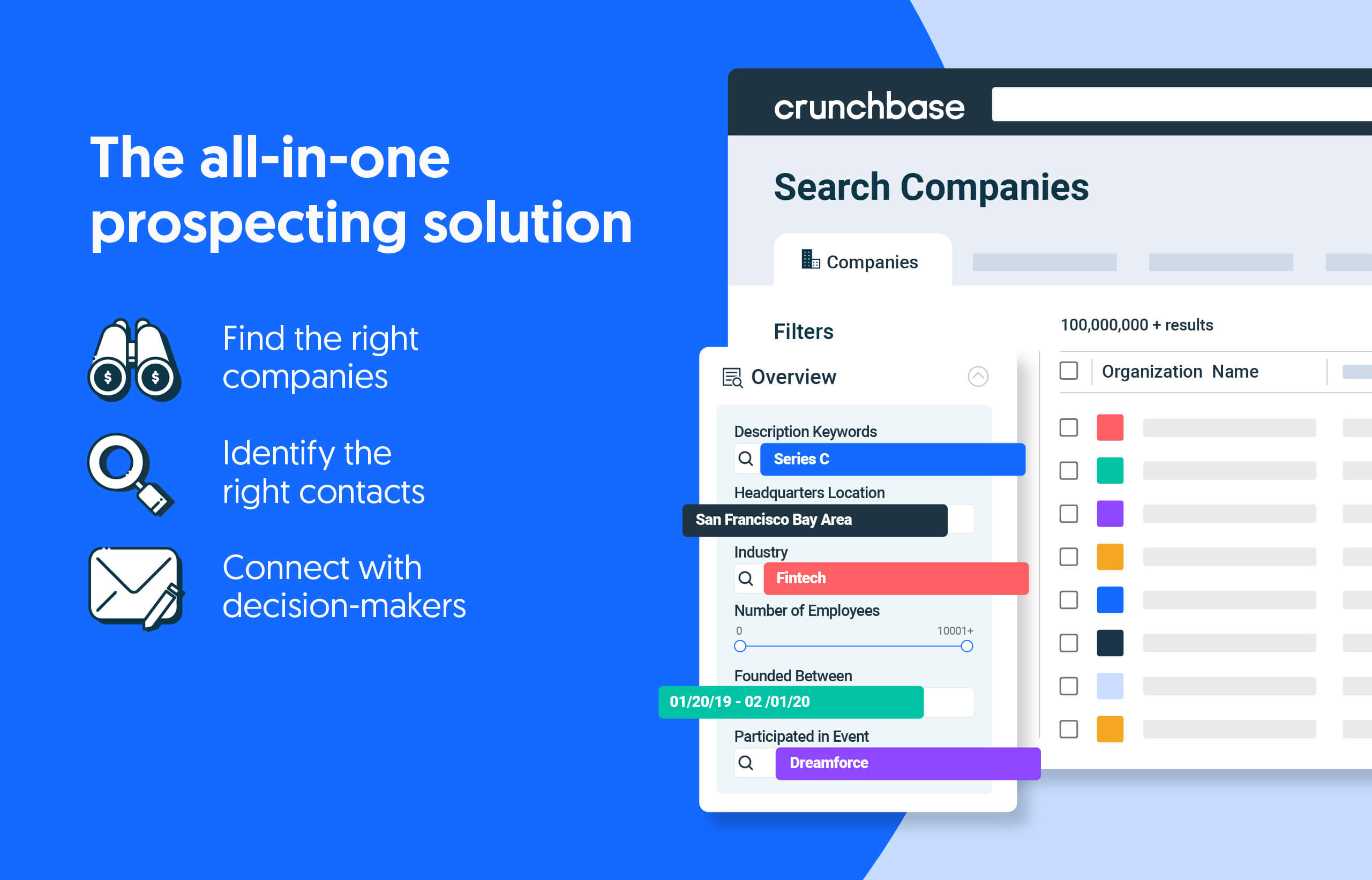As the curtain falls on venture capital investment in 2022, the reviews are in, and they are mixed.
Venture and growth investors in private companies scaled back their investment pace significantly in the latter half of 2022, signaling a slower funding climate as we begin 2023.
To be fair, 2021 was a tough act to follow. Fast-growing startups were showered with capital, and tech firms went public at high valuations. Acronyms like SPAC and NFT were golden tickets to cash. Every type of investor had a role to play and there was every reason to believe the lavish show would go on in 2022.
Search less. Close more.
Grow your revenue with all-in-one prospecting solutions powered by the leader in private-company data.
But last year’s funding numbers said otherwise. Global venture funding in 2022 reached $445 billion — marking a 35% decline year over year from the $681 billion invested in 2021 — according to an analysis of Crunchbase data. But despite the slower funding environment in 2022, investors spent $100 billion more last year than the $342 billion invested in 2020.
Indications that 2021 might be an outlier amid global funding’s more measured rise over the years instead of a new, heady normal, developed fairly quickly in 2022. The stock market’s fall, mass tech layoffs and crypto’s collapse left many investors and startups struggling to match 2021’s successes. Suddenly $445 billion of global venture funding in a year doesn’t look so bad.
Table of Contents
- Quarterly down
- Seed funding
- Early-stage funding
- Late-stage funding
- Unicorn pace slows
- A reckoning
- Methodology
- Glossary of funding terms
Quarterly down
Much of the 2022 decline was weighted in the second half of the year. Funding in the fourth quarter was marginally below the third quarter, which had already declined significantly, particularly at late-stage financings.
Fourth-quarter funding totaled $77 billion — down 6% quarter over quarter and 59% year over year — making it the lowest since the first quarter of 2020, when $70 billion was invested.
As each funding stage attracts distinct investors, and is impacted in different ways through the downturn, let’s review funding for each quarter by stage.
Seed funding
Seed funding was the least impacted funding stage through last year’s downturn.
The fourth quarter was the first quarter in 2022 when seed-stage funding fell in a year-over-year comparison. Seed funding totaled $7 billion in Q4, down 35% year over year. The third quarter in 2022 was flat year over year, but the first two quarters were higher than a year earlier.
Early-stage funding
Early-stage funding totaled $31 billion in Q4, down by 54% year over year. The third quarter was also a much slower funding quarter, down 39% year over year. Prior to that, the first quarter was up and the second quarter down by less than 10% compared to a year earlier.
Series B fundings were down by a greater percentage than Series A fundings these past two quarters.
Late-stage funding
The pullback in late-stage funding started in the second quarter of 2022 and continued through each consecutive quarter.
Late-stage and technology growth funding was $40 billion, down 64% year over year for this past quarter, from $110 billion in Q4 2021, and flat quarter over quarter according to an analysis of Crunchbase data.
Unicorn pace slows
As expected, unicorn creation also slowed in Q4, when just 22 new unicorn companies joined The Crunchbase Unicorn Board. That’s below the lowest quarterly count since the first quarter of 2020 with 23 new unicorns.
New unicorns in peak quarters in 2021 numbered over 150 companies joining per quarter.
A reckoning
The venture industry faced a reckoning in 2022.
In the pandemic-heavy days of 2021, startups growing the fastest were rewarded with abundant capital. A record number of technology startups went public well above their last private valuations and soared on listing. Momentum for special-purpose acquisition company IPOs peaked and reached 613 listings. Thousands of buyers bought NFTs valued in the millions of dollars. And Bitcoin peaked at $65,000 in November 2021.
Capital to private companies came from an array of investors; venture firms with bigger pockets, sovereign wealth funds, private equity and hedge funds committed more to private tech, and corporate investors leaned into innovation in part by funding innovative tech companies.
As we entered 2022, the stock market crashed and spiraling public valuations put pressure on private company values. As capital became more expensive, conserving cash and demonstrating unit economics was advised by investors across the spectrum over the months that followed.
The market for NFTs slid, crypto dropped — and has not emerged as a technology with a strong use case, outside of a store of value.
The “Great Resignation” theme of 2021 turned on a dime in 2022 as broad layoffs hit across large and small public and private tech companies.
And the myth of the cleverest investor in the room was punctured with the collapse of FTX eviscerating $38 billion in value.
Even artificial intelligence seemed to fall short of its potential with the closure of Argo AI, a self-driving technology company that was unable to raise further funding despite its backing from VW and Ford. However, one bright spot in 2022 was the release of OpenAI projects DALL-E for text to image creation and ChatGPT for conversational AI, an indication of productivity gains to be had from developments in AI.
The scaling back of late-stage funding will impact startups in 2023 as they prepare to raise funding at Series B and later. Round sizes have already come down, but investors will also be more cautious as a slew of startups —having held back — get ready to raise.
Methodology
The data contained in this report comes directly from Crunchbase, and is based on reported data. Data reported is as of Jan. 4, 2023.
Note that data lags are most pronounced at the earliest stages of venture activity, with seed funding amounts increasing significantly after the end of a quarter/year.
Please note that all funding values are given in U.S. dollars unless otherwise noted. Crunchbase converts foreign currencies to U.S. dollars at the prevailing spot rate from the date funding rounds, acquisitions, IPOs and other financial events are reported. Even if those events were added to Crunchbase long after the event was announced, foreign currency transactions are converted at the historic spot price.
Glossary of funding terms
Seed and angel consists of seed, pre-seed and angel rounds. Crunchbase also includes venture rounds of unknown series, equity crowdfunding and convertible notes at $3 million (USD or as-converted USD equivalent) or less.
Early-stage consists of Series A and Series B rounds, as well as other round types. Crunchbase includes venture rounds of unknown series, corporate venture and other rounds above $3 million, and those less than or equal to $15 million.
Late-stage consists of Series C, Series D, Series E and later-lettered venture rounds following the “Series [Letter]” naming convention. Also included are venture rounds of unknown series, corporate venture and other rounds above $15 million.
Technology growth is a private-equity round raised by a company that has previously raised a “venture” round. (So basically, any round from the previously defined stages.)
Illustration: Dom Guzman

Stay up to date with recent funding rounds, acquisitions, and more with the Crunchbase Daily.




![Illustration of a guy watering plants with a blocked hose - Global [Dom Guzman]](https://news.crunchbase.com/wp-content/uploads/quarterly-global-3-300x168.jpg)
67.1K Followers